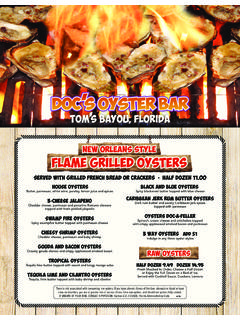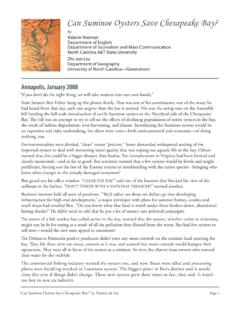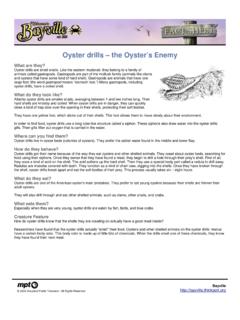Transcription of S M A L L - S C A L E OYSTER FARMING
1 1S M A L L - S C A L E OYSTER FARMING FOR PLEASURE AND PROFITIN WASHINGTONOur region s OYSTER - FARMING heritage dates back the mid-1800s, three decades before President Benjamin Harrison declared Washington the 42nd state in the Union. Some historians have suggested that the abundance of native oysters may have inspired Washington s founding fathers to choose the city of Olympia as the state many shoreline property owners or leaseholders in Washington, the appeal of rearing oysters is as strong as it was way back then.
2 This publication offers practical advice to those individuals, to encourage the sustainable use of intertidal resources while keeping alive a time-honored tradition of OYSTER FARMING in our BASICSO ysters are mollusks shelled invertebrates (or animals without backbones) in the same zoological phylum, Mollusca, as the mussel, clam, abalone, snail, octopus and squid. oysters are also classified as bivalves. Their shells are in two parts, or valves, held together by an elastic ligament hinge. An OYSTER makes its own shell, secreting calcium and other materials from glandular tissue in its soft flesh.
3 Worldwide, there are more than 100 living OYSTER species. Several of these are particularly well suited for culturing in Washington adapted for an aquatic existence, oysters have gills for breathing. As water is drawn across the gills, these feathery organs also collect particles of food from the water that surrounds them. Some species live in deep enough water to avoid being exposed to the air at low tide. Those that settle in shallower seas must deal periodi-cally with exposure to the elements. For protection, they clamp their two-part shells tightly together, using their powerful adductor muscles to hold tight (the dark spots on the inside of an empty shell are the points where the ends of this muscle once adhered).
4 Now sealed, the OYSTER can retain enough moisture to survive for hours, or, if necessary, several days out of water. Members of the genus Ostrea and Ostreola (which includes the Olympia and European flat oysters ) are hermaphroditic that is, they have both male and female reproductive organs. They first mature into males (in about one year) and then change to the female state after spawning. A regular alternation of sexes apparently con-tinues throughout life. Members of the genus Crassostrea (Pacific and Kumamoto oysters ) also develop first as males.
5 After the first year, the population divides into males and females, usually with no further sex reversals. However, an occasional hermaphrodite has been found. oysters in the genus Crassostrea shed sperm or eggs into the water, where fertilization, hatching and larval develop-ment take place. In Washington, this process occurs in mid-summer, when water temperatures reach about 700F. However, with Ostrea oysters , the males release sperm into the water, but the eggs are fertilized within the branchial chamber (the space between the gills) of the female.
6 The brood continues to develop for about ten days before being discharged into the water in the late spring when high-tide water temperatures reach about 55 F for the Olympia OYSTER (Ostreola conchaphila) and about 65 F for the European flat OYSTER (Ostrea edulis). Once in the water, larvae become part of the planktonic community and gradually undergo several changes. After three to four weeks, the larvae metamorphose to the juve-nile form and are ready to settle on and attach to suitable substrates. At this time, OYSTER growers place various kinds of material into the water to catch the larvae, in essence providing the young oysters with a home.
7 This process is called cultching. The catching materials are referred to as cultch and the recently settled oysters are known as spat. Old shells from previously harvested oysters are commonly used as BRIEF HISTORY OF OYSTER FARMING IN WASHINGTONThe Washington OYSTER industry began in the mid-1800s to supply California s demand for oysters . The fishery focused on the native or Olympia OYSTER , which was harvested primarily from Willapa Bay and the southern portions of Puget Sound. Olympia OYSTER harvests peaked in the 1890s and declined sharply with almost no harvests by 1915.
8 The decline was probably due to a variety of factors including over-harvesting in Willapa Bay and pollution from industry in Puget Sound. In 1895, Washington s Legislature passed the Bush Act and the Callow Act, both of which allowed for sale of tidelands into private ownership. This private own-ership of the tidelands, which is unique to Washington, is the foundation of the state s very successful shellfish the decline of native oysters and consumers desire for larger oysters , the eastern (or American) OYSTER was imported into Washington waters in the early 1900s.
9 Although the oysters grew well, they experienced massive mortalities, with little subsequent harvest. In addition, the Pacific OYSTER was being consid-ered for culture. Following successful trial plantings, the first shipment of Pacific OYSTER seed from Japan was received in 1922. After surviving the trans-Pacific crossing, Pacific oysters planted in Washington grew rapidly and were ready to harvest in two years. Initially relying entirely on imported seed, Washington s Pacific OYSTER industry was later aided by natural seed sources in Willapa Bay and Dabob and Quilcene bays in Hood Canal.
10 Imported seed from Japan continued to supplement the OYSTER industry though the 1970s, but hatchery-produced seed has now replaced the FARMING is structured to take advantage of the OYSTER s biology and life cycle. A basic understanding of these topics will greatly improve the productivity and market-ability of one s product. 3 FOUR COMMONLY FARMED oysters IN WASHINGTONP acific OYSTER (Crassostrea gigas)Distribution:Originally introduced from Japan, this OYSTER is now the most important commercial species along the Pacific Coast of North America and may be most suitable for beginning growers.









